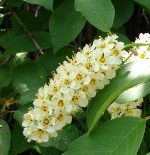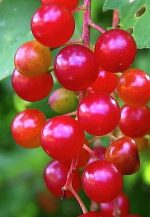 Growing 20-30 ‘tall, choke cherry is a deciduous suckering shrub or small tree and a member of the rose family, Rosaceae, that also includes lady’s mantle, pyracantha, and almonds. It is native to North American and grows in most of the US, including Alaska , but not in some southeastern states. The egg-shaped leaves are up to five inches long, have sharply toothed margins, and are dark green above and gray-green below before turning golden yellow to orange in the fall. Fragrant white flowers appear in elongated clusters 3-6” long in mid-spring and are attractive to butterflies. Each flower is ½” across, cup-shaped, five lobed, and gives way to pea-sized berries that ripen to red, purple, or blue-black. The berries have a bitter and sour taste but are used for cooking, and are attractive to birds and mammals. Good choice for a native plant garden but be aware that it may attract tent caterpillarsThe genus name, Prunus, comes from the Greek word προύνη meaning plum, a prominent member of this genus. The specific epithet, virginiana, refers a location where the plant was found.
Growing 20-30 ‘tall, choke cherry is a deciduous suckering shrub or small tree and a member of the rose family, Rosaceae, that also includes lady’s mantle, pyracantha, and almonds. It is native to North American and grows in most of the US, including Alaska , but not in some southeastern states. The egg-shaped leaves are up to five inches long, have sharply toothed margins, and are dark green above and gray-green below before turning golden yellow to orange in the fall. Fragrant white flowers appear in elongated clusters 3-6” long in mid-spring and are attractive to butterflies. Each flower is ½” across, cup-shaped, five lobed, and gives way to pea-sized berries that ripen to red, purple, or blue-black. The berries have a bitter and sour taste but are used for cooking, and are attractive to birds and mammals. Good choice for a native plant garden but be aware that it may attract tent caterpillarsThe genus name, Prunus, comes from the Greek word προύνη meaning plum, a prominent member of this genus. The specific epithet, virginiana, refers a location where the plant was found.
 Type: Deciduous, flowering shrub or small tree
Type: Deciduous, flowering shrub or small tree
Outstanding Features: Flowers, berries
Form: Irregular, oval crown
Growth Rate: Rapid
Bloom: Fragrant white cup-shaped flowers ½” across in elongated clusters 3-6” long in mid-spring
Size: 10-20’ H x 15’20’ W
Light: Full sun to partial shade but flowering best in full sun
Soil: Average, dry to medium moisture, well-drained
Hardiness: Zones 2-7
Care: Restrict suckering when needed.
Pests and Diseases: Many fungal diseases such as leaf spot, die back, leaf curly, powdery mildew, root rot, and fire blight; many insects pests such as aphids, borers, caterpillars, Japanese beetles, leafhoppers, scale, spider mites
Propagation: Seed, division